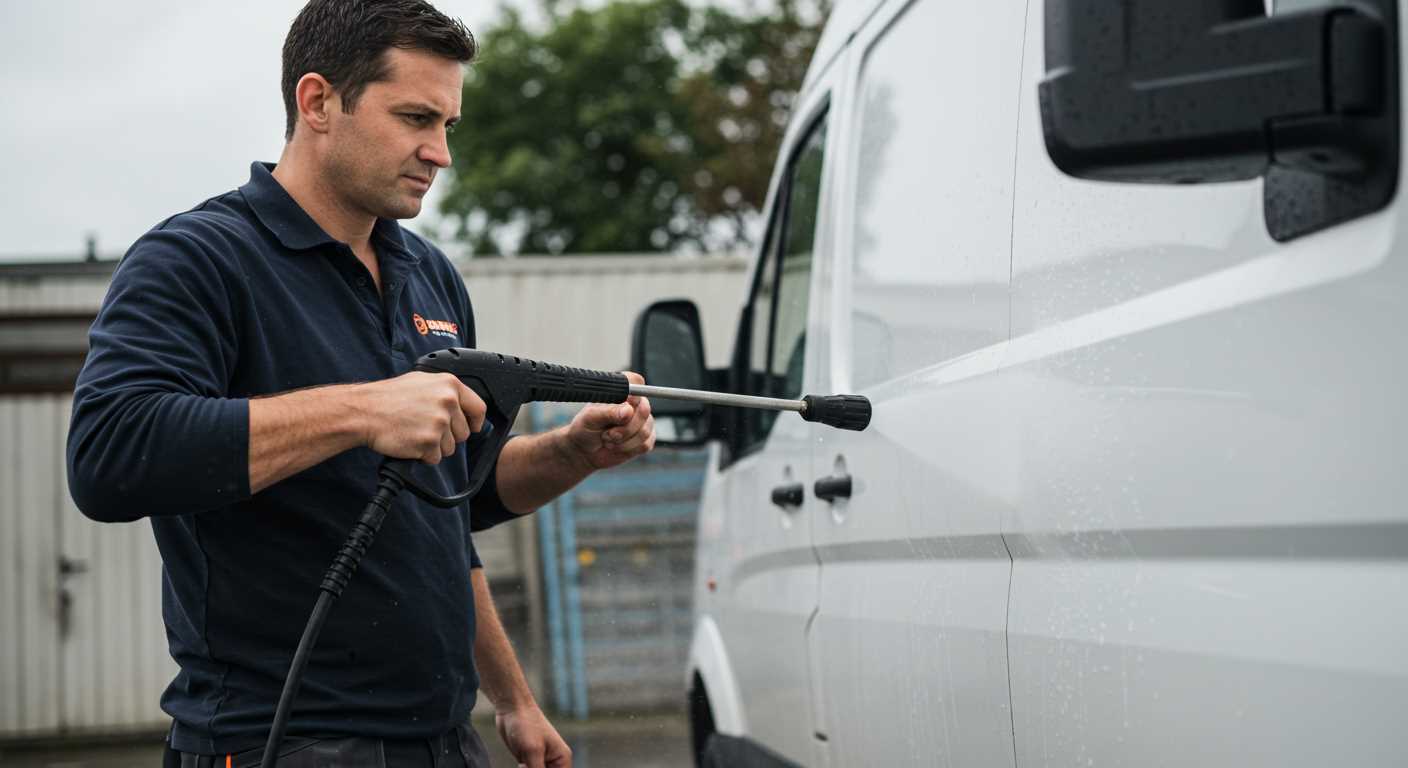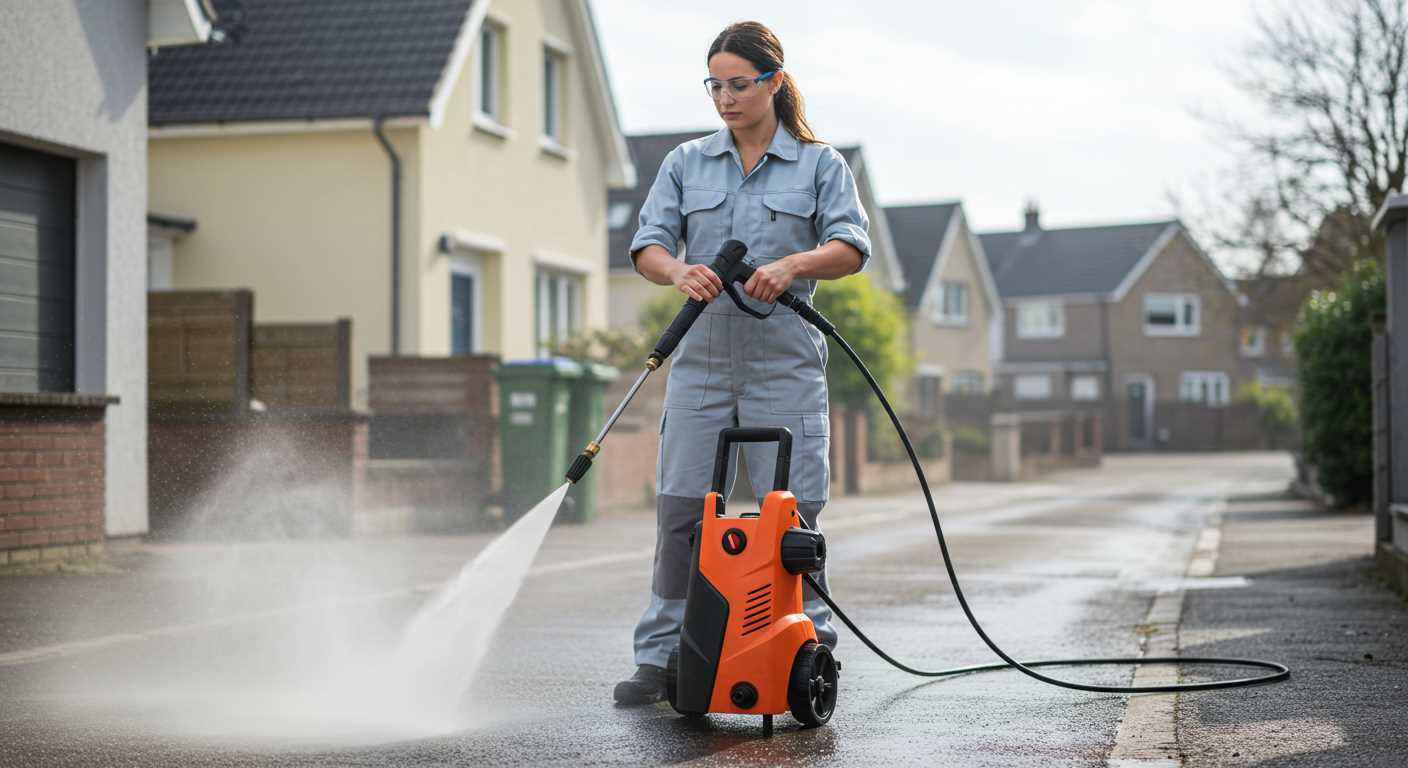



Simplify your setup process by following these straightforward steps. First, ensure that you have all necessary elements, including water supply, garden hose, and the machine itself, ready and accessible. You’ll need a standard water tap for the water source.
Next, attach the garden hose securely to the outlet on your cleaning device. Check for any leaks by tightening the connection. A good grip will prevent any unwanted interruptions during use. It’s vital to ensure that the hose is free from knots or kinks for an uninterrupted flow.
Before starting up the machine, ensure the water supply is turned on to avoid damage due to running the unit dry. Priming the pump can significantly enhance performance. Here’s a tip: run the water through the system for a minute before starting the engine to ensure it is fully primed. This practice not only protects the unit but optimises its functionality.
Finally, once everything is in place, follow the operational guidelines as stated in the manufacturer’s instructions. This ensures that you achieve the best performance from your apparatus without risking any malfunctions. Keeping safety in mind is key, so don’t forget your personal protective equipment before you commence cleaning.
Choosing the Right Location for Your Cleaning Equipment
Place your equipment on a flat, stable surface to prevent tipping or moving during operation. Avoid areas with loose gravel or uneven ground. Opt for a concrete or paved area for safety and stability.
Proximity to Water Source
.jpg)
Position close to a water supply for convenience. Ensure that the hose length allows easy access to taps while maintaining enough slack to prevent kinking. If using a hose reel, make sure it is easily reachable.
Ventilation and Safety
Establish the unit in a well-ventilated area. This aids in dispersing exhaust fumes and reduces heat build-up. Keep the area clear of flammable materials and have sufficient space around the machine for safe operation and maintenance.
Consider parking the equipment away from pedestrian traffic to avoid accidents. Maintaining a clean workspace will also help in ensuring safety and efficiency while you operate your cleaning device.
Installing the garden hose and connecting it properly
Begin with selecting a high-quality garden hose with a suitable diameter, typically 3/4 inch, for optimal water flow. Ensure the hose is compatible with your equipment specifications.
Inspect both ends of the hose: remove any debris or dirt from the connectors. A clean surface prevents leaks and ensures a reliable water supply. Make a secure attachment to the source, using a hose bib or tap. Tighten by hand to avoid damaging the fittings.
Next, connect the opposite end of the hose to the inlet of the machine. It’s crucial to align the connector properly; a misaligned fit can lead to water leaks or pressure drops during operations. Hand-tighten firmly, ensuring a snug fit without overtightening.
Before activating the unit, check for kinks or bends along the hose which could impede water flow. Lay the hose flat to prevent these issues and improve efficiency.
Once all connections are secure, turn on the water supply. Observe for any leaks at the connections. If any are present, tighten as necessary. Let the water run for a minute to prime the system before starting the unit.
After these steps, your set-up is ready for operation. This careful installation enhances functionality and prolongs the life of your equipment.
Filling the Fuel Tank Safely and Efficiently
Ensure the engine is cool before starting the refuelling process to prevent ignition hazards. I always recommend using a funnel to avoid spills, which can create slippery conditions and attract unwanted debris.
Recommended Steps for Refuelling

- Locate the fuel tank cap, usually marked clearly for easy identification.
- Remove the cap and inspect the fuel level to gauge how much more is required.
- Fill the tank with the appropriate fuel, avoiding overfilling to prevent excess spillage.
- Replace the fuel cap securely to ensure no leaks occur during operation.
Safety Precautions
- Avoid smoking or using open flames near the refuelling area.
- Keep a fire extinguisher nearby, just in case of emergencies.
- Store fuel in approved containers and keep them out of direct sunlight or heat sources.
- Wash your hands thoroughly after handling fuel to prevent skin irritation or accidental ingestion.
Proper care during the refuelling process not only enhances performance but also extends the lifespan of your equipment. Take these steps seriously for a safer and more efficient experience.
Attaching the high-pressure hose to the cleaner
Begin by locating the inlet for the high-pressure hose on the unit. Ensure that the area is clean and free from any debris, as this might interfere with the connection. Take the end of the high-pressure hose and align it with the fitting, ensuring the thread is correctly positioned.
Securing the connection
Once aligned, hand-tighten the hose until snug. Avoid using excessive force as this can damage the fitting. If you notice a rubber washer included with the hose, ensure it is properly seated within the fitting to prevent leaks. After securing, perform a visual inspection to confirm that everything appears tight and correctly assembled.
Testing for leaks
After the hose is attached, turn on the water supply and start the engine. Allow it to run for a moment while monitoring the connection for any signs of leaking. If you spot any water escaping, disconnect and re-check the fitting to ensure everything is secure. This step helps to ensure a smooth operation without interruptions.
Attaching the spray gun and nozzle correctly
Ensure the high-pressure hose is securely fastened to the spray gun before proceeding. Position the spray gun on a stable surface, aligning it properly with the hose attachment point. Rotate the hose clockwise until you feel it tighten; avoid over-tightening as this may cause damage.
Selecting the right nozzle
Choose a nozzle appropriate for your cleaning task. Different nozzles vary in spray patterns and intensity. For delicate surfaces, use a wider spray angle to prevent damage. For stubborn grime, opt for a narrower jet. Insert the selected nozzle into the spray gun until it clicks into place, signalling it is locked. Give it a slight tug to confirm its secure fit.
Testing the system
Before commencing your task, carry out a brief test. With the engine off, turn on the water supply and press the trigger on the spray gun to release any trapped air. Once the flow is steady and uninterrupted, turn on the engine. Start with a low-pressure setting to ensure everything operates smoothly before increasing the pressure for your cleaning needs.
Checking for leaks and ensuring proper connections
Before you operate the machine, verify all connections for leaks. Start by inspecting the hoses and fittings carefully. Look for any signs of wear, cracks, or loose components. It is crucial to ensure that everything is secured tightly to prevent any potential accidents or damage.
Steps to Follow

1. Turn on the water supply without starting the engine. Check all hose connections for leaks. Water should not trickle or spray from any joint.
2. If you notice any issues, turn off the water supply and make necessary adjustments. Use Teflon tape on threaded connections to improve sealing, if required.
3. After securing all the fittings, proceed to attach the high-pressure hose. Ensure the connection is snug and free from any obstructions that might affect the seal.
Leak Detection Table

| Connection Point | Common Issues | Solution |
|---|---|---|
| Hose to nozzles | Worn rubber ring | Replace the joint or ring |
| High-pressure hose joint | Loose fitting | Tighten securely |
| Inlet hose connection | Cracked hose | Replace hose |
After confirming that all components are leak-free, proceed to test the unit without engaging any high-pressure features. Observe for any unusual sounds or loss of pressure, which might indicate unseen issues. If everything checks out, you are ready for efficient operation.
Starting the Cleaning Equipment for the First Time
Ensure the choke is in the correct position based on the temperature: close it for cold starts and open it for warm conditions. With this adjusted, grip the handle securely and engage the ignition switch, if equipped.
Next, firmly pull the start cord with a smooth and rapid motion, paying attention to any resistance. If the engine does not ignite within a couple of attempts, reconsider the choke setting and repeat the starting process. After the initial start-up, allow the engine to run for about 5 minutes to warm up before proceeding with any cleaning tasks.
During the warm-up phase, monitor the engine sound, ensuring it operates smoothly without irregular noises. Check for any vibrations that may indicate an issue. Once the machine is running reliably, it’s time to adjust the spray settings to suit your intended cleaning task.
Always be prepared to switch off the engine if any anomalies arise during operation. Keeping a keen ear and eye on the equipment ensures a seamless cleaning experience.
When you’re ready to begin cleaning, engage the trigger on the spray gun to release water. This will confirm that pressure is building effectively in the system. If there are any unexpected delays in pressure, turn off the unit and review the connections once more.








